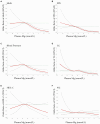Association and dose-response relationship of plasma magnesium with metabolic syndrome in Chinese adults older than 45 years
- PMID: 38419852
- PMCID: PMC10899336
- DOI: 10.3389/fnut.2024.1346825
Association and dose-response relationship of plasma magnesium with metabolic syndrome in Chinese adults older than 45 years
Abstract
Purpose: Magnesium (Mg) is an essential nutrient for the maintenance of vital physiological functions. Magnesium deficiency is associated with diseases such as obesity, type 2 diabetes mellitus (T2DM), and metabolic syndrome (MetS); however, conclusions have been inconsistent, and there is a particular lack of evidence regarding this association in Chinese population older than 45 years. This study aimed to assess the association between plasma magnesium and the risk of MetS and its components, the dose-response relationship, and the threshold effect relationship in a Chinese population involving older than 45 years.
Methods: A total of 2,101 individuals were randomly selected from the China Nutrition and Health Surveillance (CNHS) (2015-2017) by considering monitoring points. We used the joint statement of the International Diabetes Federation (IDF) in 2009 to define participants with MetS. The plasma magnesium was tested by inductively coupled plasma mass spectrometry (ICP-MS). The logistic regression and restricted cubic spline (RCS) models were used to analyze the association and dose-response relationship between plasma Mg and MetS and its components.
Results: Compared with the lowest quintile (Q1) for plasma Mg, the odds ratios (ORs) and 95% confidence intervals (95% CI) for MetS, impaired fasting glucose (IFG), hypertension, and triglyceride (TG) elevation at the highest quintile (Q5) were 0.419 (0.301, 0.583), 0.303 (0.221, 0.415), 0.446 (0.322, 0.618), and 0.526 (0.384, 0.720), respectively, with all p < 0.05. However, in the components of decreased high-density lipoprotein cholesterol (HDL-C) and central obesity, no trend toward lowering with higher plasma magnesium was observed (p = 0.717, p = 0.865). These associations were not altered by further adjustment for potential confounding variables, including age, gender, education, nationality, area, residence, body mass index (BMI), and heart rate. The RCS analysis showed that, when plasma magnesium was lower than 0.85 mmol/L, the curve was leveled off, and then, the curve showed a decreasing trend with the increase in plasma magnesium.
Conclusion: Therefore, plasma Mg was negatively associated with MetS and its components (including IFG, hypertension, and elevated TG) in people older than 45 years. In addition, plasma Mg greater than or equal to 0.85 mmol/L, which is higher than the commonly used threshold of 0.75 mmol/L, may be protective against MetS and its components (including elevated FPG, elevated blood pressure, and elevated TG). More prospective studies, such as randomized controlled trials, are necessary to confirm the effective impact of Mg on MetS and its components. Plasma Mg levels in the MetS population older than 45 years require attention.
Keywords: Chinese adults; IFG; hypertension; magnesium; metabolic syndrome.
Copyright © 2024 Yang, Cao, Zhang, Hu, Lu, Wang, Feng and Yang.
Conflict of interest statement
The authors declare that the research was conducted in the absence of any commercial or financial relationships that could be construed as a potential conflict of interest.
Figures

Similar articles
-
Relationship between Dietary Magnesium Intake and Metabolic Syndrome.Nutrients. 2022 May 11;14(10):2013. doi: 10.3390/nu14102013. Nutrients. 2022. PMID: 35631154 Free PMC article.
-
Associations of multiple plasma metals with the risk of metabolic syndrome: A cross-sectional study in the mid-aged and older population of China.Ecotoxicol Environ Saf. 2022 Feb;231:113183. doi: 10.1016/j.ecoenv.2022.113183. Epub 2022 Jan 13. Ecotoxicol Environ Saf. 2022. PMID: 35032729
-
Associations of the metabolic syndrome and its components with cognitive impairment in older adults.BMC Geriatr. 2019 Mar 7;19(1):77. doi: 10.1186/s12877-019-1073-7. BMC Geriatr. 2019. PMID: 30845934 Free PMC article.
-
Is non-high-density lipoprotein associated with metabolic syndrome? A systematic review and meta-analysis.Front Endocrinol (Lausanne). 2022 Sep 13;13:957136. doi: 10.3389/fendo.2022.957136. eCollection 2022. Front Endocrinol (Lausanne). 2022. PMID: 36176470 Free PMC article.
-
Interrelationships among metabolic syndrome, bone-derived cytokines, and the most common metabolic syndrome-related diseases negatively affecting bone quality.Diabetol Metab Syndr. 2024 Sep 6;16(1):217. doi: 10.1186/s13098-024-01440-7. Diabetol Metab Syndr. 2024. PMID: 39238022 Free PMC article. Review.
Cited by
-
Intake or Blood Levels of Magnesium and Risk of Metabolic Syndrome: A Meta-Analysis of Observational Studies.Nutrients. 2025 May 14;17(10):1667. doi: 10.3390/nu17101667. Nutrients. 2025. PMID: 40431407 Free PMC article. Review.
-
Association between Magnesium Depletion Score and Advanced Cardiovascular-Kidney-Metabolic Syndrome Stages in US Adults.Int J Med Sci. 2025 Jun 23;22(12):3101-3111. doi: 10.7150/ijms.115217. eCollection 2025. Int J Med Sci. 2025. PMID: 40657384 Free PMC article.
-
Hypomagnesemia: exploring its multifaceted health impacts and associations with blood pressure regulation and metabolic syndrome.Diabetol Metab Syndr. 2025 Jun 16;17(1):217. doi: 10.1186/s13098-025-01772-y. Diabetol Metab Syndr. 2025. PMID: 40524199 Free PMC article. Review.
References
-
- Yuna H, Wenhua Z, Liyun Z, Dongmei Y, Jian Z, Xiaoguang Y, et al. . Epidemiological characteristics of adult metabolic syndrome in China, 2010-2012. Chin J Epidemiol. (2017) 38:212–5. doi: 10.3760/cma.j.issn.0254-6450.2017.02.015 - DOI
LinkOut - more resources
Full Text Sources
Miscellaneous

